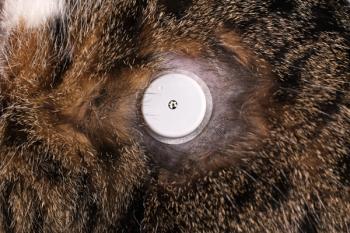
Hot Literature: Hyperadrenocorticism: Is lower-dose trilostane the answer?
The goal of this study was to evaluate the effects of lower-dose trilostane treatment.
Trilostane inhibits the enzyme system involved in the synthesis of cortisol and aldosterone. It has become widely used to treat dogs with hyperadrenocorticism, but dosage regimens are still evolving.
Thomas Strand/Getty Images
Currently in the United States, the manufacturer recommends a dose of 2.2 to 6.7 mg/kg given orally once a day. Recent studies, however, have shown that dogs can be successfully managed on lower doses and may in fact have fewer adverse events if treated with a twice-daily instead of once-daily approach. The goal of the study described here was to evaluate the effects of lower-dose trilostane treatment given twice daily to dogs with naturally occurring hyperadrenocorticism.
STUDY DESIGN
A total of 47 dogs were included in the study—38 dogs with pituitary-dependent hyperadrenocorticism (PDH) and nine dogs with adrenal-dependent hyperadrenocorticism (ADH). PDH was diagnosed based on two out of three test results: a low-dose dexamethasone suppression (LDDS) test supportive of hyperadrenocorticism; ultrasonographic evidence of bilaterally symmetric, enlarged adrenal glands; or an endogenous ACTH concentration > 45 pg/ml. ADH was diagnosed if all of the following criteria were met: an abnormal LDDS test result, an endogenous ACTH concentration below the reference range, ultrasonographic evidence of an adrenal mass, and histologic confirmation of an adrenal tumor.
The initial trilostane dose was 0.2 to 1.1 mg/kg given orally every 12 hours, and dogs were reevaluated after one to two weeks of treatment and again at two months, six months, and one year after therapy was initiated. All dogs with ADH were treated for at least two months in preparation for adrenalectomy in an effort to reduce the incidence of complications with anesthesia and surgery. At reevaluation, an ACTH stimulation test was performed on all dogs about three hours after the last dose of trilostane. A urinalysis was also performed at each reevaluation to assess specific gravity and urine cortisol to creatinine ratio (UCCR).
The goal of therapy was to achieve a post-ACTH cortisol concentration within 1.5 to 5.5 µg/dl, and dose adjustments were made based on test results as well as owner observations and physical examination findings.
STUDY RESULTS AND SIGNIFICANCE
No statistical difference was present between dogs with PDH or ADH with respect to age or weight. The mean initial dosage of trilostane for all dogs was 0.86 mg/kg given every 12 hours.
Dogs with PDH were classified into three groups based on the results of a follow-up ACTH stimulation test as well as the owners' perception of response to therapy.
- Group 1 included 15 dogs in which the trilostane dose either remained the same or was decreased during the study based on improved post-ACTH cortisol concentrations as well as perceived improvement in clinical signs. In three dogs that had clinical signs of illness, trilostane use was discontinued for four or five days. Once signs improved, trilostane administration was reinstituted with a 50% dose decrease.
- Group 2 consisted of 16 dogs for whom an increase in the trilostane dose (25% to 50%) was required based on elevated post-ACTH cortisol concentrations.
- Group 3 was composed of seven dogs that had the frequency of trilostane administration increased to every eight hours. These changes were made based on post-ACTH cortisol concentration results as well as owners' perception of clinical response.
In dogs that had a good response at the one-year reevaluation, the mean trilostane dosage was 1.7 mg/kg given twice daily or 1.1 mg/kg given three times a day.
None of the dogs with ADH required an increase in their trilostane dose and all appeared to respond well clinically, suggesting that adrenocortical tumors are sensitive to trilostane. After the second reevaluation, all nine dogs had successful surgical removal of an adrenocortical tumor and subsequent trilostane discontinuation.
The study found that neither the UCCR or urine specific gravity was a reliable indicator of therapeutic response and could not be used to determine if dosing adjustments were required.
Interestingly, some dogs in the study had clinical evidence of illness (anorexia, lethargy, vomiting) despite cortisol concentrations that may not be as low as expected. This may be because trilostane may more effectively inhibit mineralocorticoid synthesis in this population of dogs while cortisol concentrations may be less affected.
Overall, five of the 47 dogs appeared to have adverse reactions to trilostane, but unrelated conditions may have resulted in the illnesses. Four of the five dogs with adverse effects were receiving doses well below the manufacturer's suggested dosing, a fact noted even in those dogs that were receiving medication three times a day. Additionally, these effects may occur at any point during treatment as seen in those dogs that developed problems at two months, six months, and one year after therapy was initiated.
The author of the study recommends that the goal of therapy should continue to be a post-ACTH cortisol concentration ≤ 5.5 µg/dl and urine specific gravity > 1.020 but that owner observations regarding treatment response also be considered. Trilostane appears to be effective at lower doses than those recommended in the literature and by the manufacturer, so a lower-dose protocol may successfully achieve a therapeutic response while decreasing the risk of adverse events. Additionally, the need to increase dosing frequency should be considered in those dogs that have an appropriate biochemical response but are still exhibiting clinical signs.
Feldman EC. Evaluation of twice-daily lower-dose trilostane treatment administered orally in dogs with naturally occurring hyperadrenocorticism. J Am Vet Med Assoc 2011;238(11):1441-1451.
This "Hot Literature" update was provided by Jennifer L. Garcia, DVM, DACVIM, a veterinary internal medicine consultant in Houston, Texas.
Newsletter
From exam room tips to practice management insights, get trusted veterinary news delivered straight to your inbox—subscribe to dvm360.






